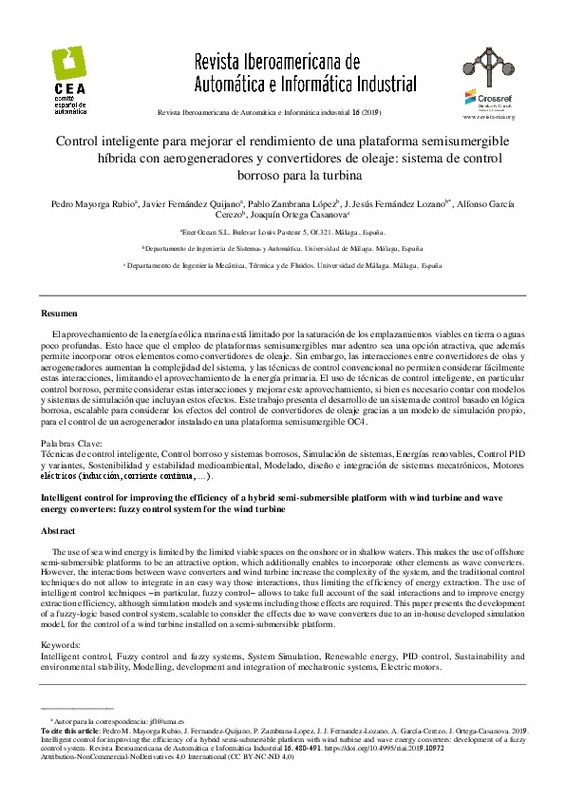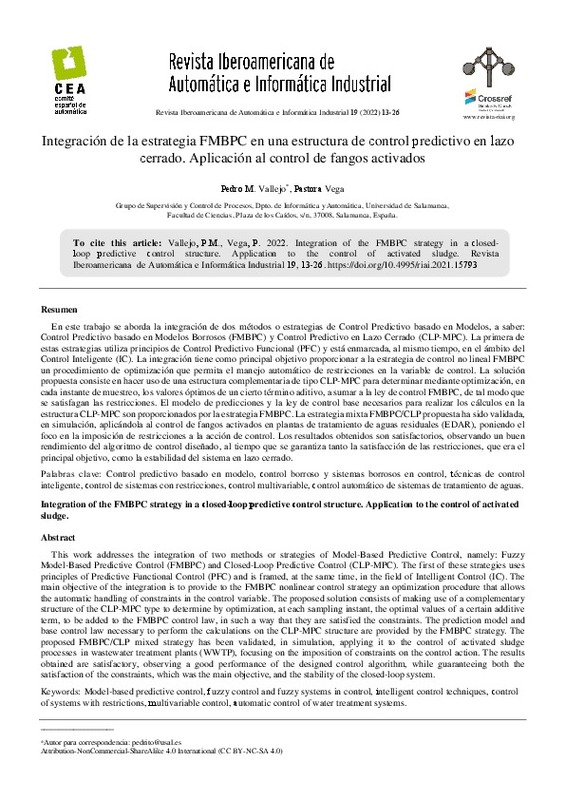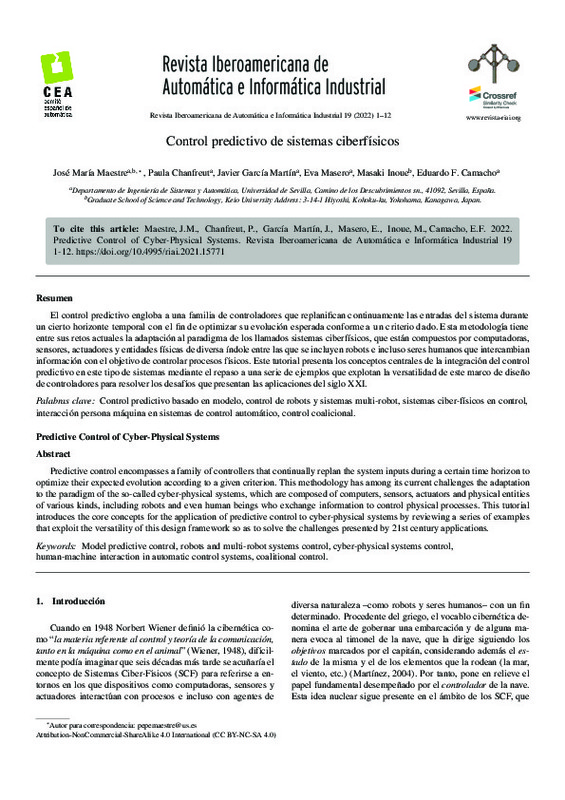JavaScript is disabled for your browser. Some features of this site may not work without it.
Buscar en RiuNet
Listar
Mi cuenta
Estadísticas
Ayuda RiuNet
Admin. UPV
Control inteligente para mejorar el rendimiento de una plataforma semisumergible híbrida con aerogenerador y convertidores de oleaje: sistema de control borroso para la turbina
Mostrar el registro sencillo del ítem
Ficheros en el ítem
| dc.contributor.author | Mayorga Rubio, Pedro
|
es_ES |
| dc.contributor.author | Fernández Quijano, Javier
|
es_ES |
| dc.contributor.author | Zambrana López, Pablo
|
es_ES |
| dc.contributor.author | Fernández Lozano, J. Jesús
|
es_ES |
| dc.contributor.author | García Cerezo, Alfonso
|
es_ES |
| dc.contributor.author | Ortega Casanova, Joaquín
|
es_ES |
| dc.date.accessioned | 2019-09-24T09:40:20Z | |
| dc.date.available | 2019-09-24T09:40:20Z | |
| dc.date.issued | 2019-09-20 | |
| dc.identifier.issn | 1697-7912 | |
| dc.identifier.uri | http://hdl.handle.net/10251/126300 | |
| dc.description.abstract | [EN] The use of sea wind energy is limited by the limited viable spaces on the onshore or in shallow waters. This makes the use of offshore semi-submersible platforms to be an attractive option, which additionally enables to incorporate other elements as wave converters. However, the interactions between wave converters and wind turbine increase the complexity of the system, and the traditional control techniques do not allow to integrate in an easy way those interactions, thus limiting the efficiency of energy extraction. The use of intelligent control techniques –in particular, fuzzy control– allows to take full account of the said interactions and to improve energy extraction efficiency, although simulation models and systems including those effects are required. This paper presents the development of a fuzzy-logic based control system, scalable to consider the effects due to wave converters due to an in-house developed simulation model, for the control of a wind turbine installed on a semi-submersible platform. | es_ES |
| dc.description.abstract | [ES] El aprovechamiento de la energía eólica marina está limitado por la saturación de los emplazamientos viables en tierra o aguas poco profundas. Esto hace que el empleo de plataformas semisumergibles mar adentro sea una opción atractiva, que además permite incorporar otros elementos como convertidores de oleaje. Sin embargo, las interacciones entre convertidores de olas y aerogeneradores aumentan la complejidad del sistema, y las técnicas de control convencional no permiten considerar fácilmente estas interacciones, limitando el aprovechamiento de la energía primaria. El uso de técnicas de control inteligente, en particular control borroso, permite considerar estas interacciones y mejorar este aprovechamiento, si bien es necesario contar con modelos y sistemas de simulación que incluyan estos efectos. Este trabajo presenta el desarrollo de un sistema de control basado en lógica borrosa, escalable para considerar los efectos del control de convertidores de oleaje; para el control de un aerogenerador instalado en una plataforma semisumergible OC4. | es_ES |
| dc.description.sponsorship | Este trabajo ha sido realizado parcialmente gracias al apoyo del Ministerio de Economía y Competitividad del Gobierno de España, a través del proyecto ORPHEO (RTC-2016-5712-3) del Plan Estatal de Investigación Científica y Técnica y de Innovación 2013-2016, Programa Estatal de Investigación, Desarrollo e Innovación orientada a los Retos de la Sociedad, y de la Unión Europea a través del proyecto WIP10+ de la convocatoria ERA-NET DEMOWIND, de CDTI (España) y BEISS (Reino Unido), a través del programa de investigación e innovación H2020. Asimismo, los autores desean agradece a D. Miguel Martín Guzmán su colaboración en este trabajo. | es_ES |
| dc.language | Español | es_ES |
| dc.publisher | Universitat Politècnica de València | |
| dc.relation.ispartof | Revista Iberoamericana de Automática e Informática. | |
| dc.rights | Reconocimiento - No comercial - Sin obra derivada (by-nc-nd) | es_ES |
| dc.subject | Técnicas de control inteligente | es_ES |
| dc.subject | Control borroso y sistemas borrosos | es_ES |
| dc.subject | Simulación de sistemas | es_ES |
| dc.subject | Energías renovables | es_ES |
| dc.subject | Control PID y variantes | es_ES |
| dc.subject | Sostenibilidad y estabilidad medioambiental | es_ES |
| dc.subject | Modelado, diseño e integración de sistemas mecatrónicos | es_ES |
| dc.subject | Intelligent control | es_ES |
| dc.subject | Fuzzy control and fuzzy systems | es_ES |
| dc.subject | System Simulation | es_ES |
| dc.subject | Renewable energy | es_ES |
| dc.subject | PID control | es_ES |
| dc.subject | Sustainability and environmental stability | es_ES |
| dc.subject | Modelling, development and integration of mechatronic systems | es_ES |
| dc.subject | Electric motors | es_ES |
| dc.title | Control inteligente para mejorar el rendimiento de una plataforma semisumergible híbrida con aerogenerador y convertidores de oleaje: sistema de control borroso para la turbina | es_ES |
| dc.title.alternative | Intelligent control for improving the efficiency of a hybrid semi-submersible platform with wind turbine and wave energy converters: fuzzy control system for the wind turbine | es_ES |
| dc.type | Artículo | es_ES |
| dc.date.updated | 2019-09-24T06:56:48Z | |
| dc.identifier.doi | 10.4995/riai.2019.10972 | |
| dc.relation.projectID | info:eu-repo/grantAgreement/MINECO//RTC-2016-5712-3/ | es_ES |
| dc.rights.accessRights | Abierto | es_ES |
| dc.description.bibliographicCitation | Mayorga Rubio, P.; Fernández Quijano, J.; Zambrana López, P.; Fernández Lozano, JJ.; García Cerezo, A.; Ortega Casanova, J. (2019). Control inteligente para mejorar el rendimiento de una plataforma semisumergible híbrida con aerogenerador y convertidores de oleaje: sistema de control borroso para la turbina. Revista Iberoamericana de Automática e Informática. 16(4):480-491. https://doi.org/10.4995/riai.2019.10972 | es_ES |
| dc.description.accrualMethod | SWORD | es_ES |
| dc.relation.publisherversion | https://doi.org/10.4995/riai.2019.10972 | es_ES |
| dc.description.upvformatpinicio | 480 | es_ES |
| dc.description.upvformatpfin | 491 | es_ES |
| dc.type.version | info:eu-repo/semantics/publishedVersion | es_ES |
| dc.description.volume | 16 | |
| dc.description.issue | 4 | |
| dc.identifier.eissn | 1697-7920 | |
| dc.contributor.funder | Ministerio de Economía y Competitividad | es_ES |
| dc.description.references | Abdullah, M. A., A. H M Yatim, C. W. Tan, and R. Saidur. 2012. "A Review of Maximum Power Point Tracking Algorithms for Wind Energy Systems." Renewable and Sustainable Energy Reviews 16(5): 3220-27. http://dx.doi.org/10.1016/j.rser.2012.02.016. | es_ES |
| dc.description.references | Alexiadis, M. C., P. S. Dokopoulos, H. S. Sahsamanoglou, and I. M. Manousaridis. 1998. "Short-Term Forecasting of Wind Speed and Related Electrical Power." Solar Energy 63(1): 61-68. https://doi.org/10.1016/S0038-092X(98)00032-2 | es_ES |
| dc.description.references | Babarit, A., and A.H. Clément. 2006. "Optimal Latching Control of a Wave Energy Device in Regular and Irregular Waves." Applied Ocean Research 28(2): 77-91. https://www.sciencedirect.com/science/article/pii/S0141118706000423?via%3Dihub (November 13, 2018). https://doi.org/10.1016/j.apor.2006.05.002 | es_ES |
| dc.description.references | Babarit, Aurélien, Michel Guglielmi, and Alain H. Clément. 2009. "Declutching Control of a Wave Energy Converter." Ocean Engineering 36(12-13): 1015-24. https://www.sciencedirect.com/science/article/pii/S0029801809001115?via%3Dihub (November 13, 2018). https://doi.org/10.1016/j.oceaneng.2009.05.006 | es_ES |
| dc.description.references | Barbounis, T G, J B Theocharis, M C Alexiadis, and P S Dokopoulos.2006. "Long-Term Wind Speed and Power Forecasting Using Local Recurrent Neural Network Models." IEEE Transactions on Energy Conversion 21(1): 273-84. https://doi.org/10.1109/TEC.2005.847954 | es_ES |
| dc.description.references | Brekken, T. K. A. 2011. "On Model Predictive Control for a Point Absorber Wave Energy Converter." In 2011 IEEE Trondheim PowerTech, IEEE, 1-8. http://ieeexplore.ieee.org/document/6019367/ (November 13, 2018). Brekken, T. K. A. 2011. "On Model Predictive Control for a Point Absorber Wave Energy Converter." In 2011 IEEE Trondheim PowerTech, IEEE, 1-8. http://ieeexplore.ieee.org/document/6019367/ (November 13, 2018). | es_ES |
| dc.description.references | Budar, K., and J. Falnes. 1975. "A Resonant Point Absorber of Ocean-Wave Power." Nature 256(5517): 478-79. http://www.nature.com/doifinder/10.1038/256478a0 (November 13, 2018). https://doi.org/10.1038/256478a0 | es_ES |
| dc.description.references | Budar, K., and J. Falnes. 1975. "A Resonant Point Absorber of Ocean-Wave Power." Nature 256(5517): 478-79. http://www.nature.com/doifinder/10.1038/256478a0 (November 13, 2018). | es_ES |
| dc.description.references | Cárdenas, Roberto, and Rubén Peña. 2004. "Sensorless Vector Control of Induction Machines for Variable-Speed Wind Energy Applications." IEEE Transactions on Energy Conversion. https://doi.org/10.1109/TEC.2003.821863 | es_ES |
| dc.description.references | Castro-Santos, Laura, Almudena Filgueira-Vizoso, Luis Carral-Couce, and José Ángel Fraguela Formoso. 2016. "Economic Feasibility of Floating Offshore Wind Farms." Energy 112: 868-82. https://www.sciencedirect.com/science/article/pii/S0360544216309094?via%3Dihub (November 9, 2018). https://doi.org/10.1016/j.energy.2016.06.135 | es_ES |
| dc.description.references | Cheng, Ming, and Ying Zhu. 2014. "The State of the Art of Wind Energy Conversion Systems and Technologies: A Review." Energy Conversion and Management 88: 332-47. https://doi.org/10.1016/j.enconman.2014.08.037 | es_ES |
| dc.description.references | Costa, Alexandre et al. 2008. "A Review on the Young History of the Wind Power Short-Term Prediction." Renewable and Sustainable Energy Reviews 12(6): 1725-44. https://doi.org/10.1016/j.rser.2007.01.015 | es_ES |
| dc.description.references | Damousis, Ioannis G., Minas C. Alexiadis, John B. Theocharis, and Petros S. Dokopoulos. 2004. "A Fuzzy Model for Wind Speed Prediction and Power Generation in Wind Parks Using Spatial Correlation." IEEE Transactions on Energy Conversion. https://doi.org/10.1109/TEC.2003.821865 | es_ES |
| dc.description.references | Ekinci, Firat, Tuǧçe Demirdelen, and Mehmet Bilgili. 2017. "Modelling of Wind Turbine Power Output by Using ANNs and ANFIS Techniques." In 7th International Conference on Innovative Computing Technology, INTECH 2017,. https://doi.org/10.1109/INTECH.2017.8102425 | es_ES |
| dc.description.references | Falnes, Johannes. 2002. Ocean Waves and Oscillating Systems. Cambridge: Cambridge University Press. http://ebooks.cambridge.org/ref/id/CBO9780511754630 (November 9, 2018). https://doi.org/10.1017/CBO9780511754630 | es_ES |
| dc.description.references | Farfán, Roberto F., Carlos A. Cadena, and Luis T. Villa. 2015. "Experiencia En El Uso de La Lógica Difusa Para El Control Del Seguimiento Del Punto de Máxima Potencia En Convertidores Para Módulos Fotovoltaicos." Revista Iberoamericana de Automática e Informática Industrial RIAI 12(2): 208-17. http://linkinghub.elsevier.com/retrieve/pii/S1697791215000102. https://doi.org/10.1016/j.riai.2015.03.004 | es_ES |
| dc.description.references | Farhat, Maissa et al. 2015. "Diseño e Implementación de Un Sistema de Control Estable Basado En Lógica Borrosa Para Optimizar El Rendimiento de Un Sistema de Generación Fotovoltaico." RIAI - Revista Iberoamericana de Automatica e Informatica Industrial 12(4): 476-87. https://doi.org/10.1016/j.riai.2015.07.006 | es_ES |
| dc.description.references | Garcia, Mari Cruz, Miguel A. Sanz-Bobi, and Javier del Pico. 2006. "SIMAP: Intelligent System for Predictive Maintenance. Application to the Health Condition Monitoring of a Windturbine Gearbox." Computers in Industry 57(6): 552-68. https://doi.org/10.1016/j.compind.2006.02.011 | es_ES |
| dc.description.references | González-González, Asier et al. 2014. "Pitch Based Wind Turbine Intelligent Speed Setpoint Adjustment Algorithms." Energies 7(6): 3793-3809. http://www.mdpi.com/1996-1073/7/6/3793 (November 9, 2018). https://doi.org/10.3390/en7063793 | es_ES |
| dc.description.references | IEC. 2009. European Committee for Electrotechnical Standardization Wind Turbines - Part 3: Design Requirements for Offshore Wind Turbines. | es_ES |
| dc.description.references | IRENA. 2017. Irena Renewable Energy Capacity Statistics 2017. | es_ES |
| dc.description.references | Jonkman, J., S. Butterfield, W. Musial, and G. Scott. 2009. "Definition of a 5-MW Reference Wind Turbine for Offshore System Development." (February). http://www.osti.gov/servlets/purl/947422-nhrlni/. https://doi.org/10.2172/947422 | es_ES |
| dc.description.references | Kariniotakis, G. N., G. S. Stavrakakis, and E. F. and Nogaret. 1996. "Wind Power Forecasting Using Advanced Neural Networks Models." IEEE Transactions on Energy Conversion 11(4): 762-67. http://ieeexplore.ieee.org/lpdocs/epic03/wrapper.htm?arnumber=556376. https://doi.org/10.1109/60.556376 | es_ES |
| dc.description.references | Kaur, Tarlochan, Sanjay Kumar, and Ravi Segal. 2016. "Application of Artificial Neural Network for Short Term Wind Speed Forecasting." 2016 Biennial International Conference on Power and Energy Systems: Towards Sustainable Energy (PESTSE): 1-5. http://ieeexplore.ieee.org/document/7516458/. https://doi.org/10.1109/PESTSE.2016.7516458 | es_ES |
| dc.description.references | Kim, Yun Su, Il Yop Chung, and Seung Il Moon. 2015. "Tuning of the PI Controller Parameters of a PMSG Wind Turbine to Improve Control Performance under Various Wind Speeds." Energies 8(2): 1406-25. https://doi.org/10.3390/en8021406 | es_ES |
| dc.description.references | Lasheen, Ahmed, and Abdel Latif Elshafei. 2016. "Wind-Turbine Collective-Pitch Control via a Fuzzy Predictive Algorithm." Renewable Energy. https://doi.org/10.1016/j.renene.2015.10.030 | es_ES |
| dc.description.references | Leung, Dennis Y C, and Yuan Yang. 2012. "Wind Energy Development and Its Environmental Impact: A Review." Renewable and Sustainable Energy Reviews 16(1): 1031-39. http://dx.doi.org/10.1016/j.rser.2011.09.024. | es_ES |
| dc.description.references | Li, Gong, and Jing Shi. 2010. "On Comparing Three Artificial Neural Networks for Wind Speed Forecasting." Applied Energy 87(7): 2313-20. https://doi.org/10.1016/j.apenergy.2009.12.013 | es_ES |
| dc.description.references | Lin, Whei-Min, and Chih-Ming Hong. 2010. "Intelligent Approach to Maximum Power Point Tracking Control Strategy for Variable-Speed Wind Turbine Generation System." Energy 35(6): 2440-47. http://linkinghub.elsevier.com/retrieve/pii/S0360544210000964. https://doi.org/10.1016/j.energy.2010.02.033 | es_ES |
| dc.description.references | Pérez de la Portilla, Marina, Amable López Piñeiro, José Andrés Somolinos Sánchez, and Rafael Morales Herrera. 2017. "Modelado Dinámico y Control de Un Dispositivo Sumergido Provisto de Actuadores Hidrostáticos." Revista Iberoamericana de Automática e Informática industrial 15(1): 12. https://polipapers.upv.es/index.php/RIAI/article/view/8824 (February 21, 2019). https://doi.org/10.4995/riai.2017.8824 | es_ES |
| dc.description.references | Pucci, Marcello, and Maurizio Cirrincione. 2011. "Neural MPPT Control of Wind Generators with Induction Machines without Speed Sensors." IEEE Transactions on Industrial Electronics 58(1): 37-47. https://doi.org/10.1109/TIE.2010.2043043 | es_ES |
| dc.description.references | Red Eléctrica de España. 2017. El Sistema Eléctrico Español. | es_ES |
| dc.description.references | Sahin, Ahmet Duran. 2004. "Progress and Recent Trends in Wind Energy." Progress in Energy and Combustion Science 30(5): 501-43. https://doi.org/10.1016/j.pecs.2004.04.001 | es_ES |
| dc.description.references | Santos, M. 2011. "Un Enfoque Aplicado Del Control Inteligente." Revista Iberoamericana de Automática e Informática Industrial RIAI 8(4): 283-96. https://www.sciencedirect.com/science/article/pii/S1697791211000501 (November 9, 2018). https://doi.org/10.1016/j.riai.2011.09.016 | es_ES |
| dc.description.references | Shahmaleki, Pourya. 2018. "Enhancing Wind Turbine's Performance Using Fuzzy Pitch and Torque Controllers." In World Automation Congress Proceedings. https://doi.org/10.23919/WAC.2018.8430410 | es_ES |
| dc.description.references | Simoes, M G, B K Bose, and R J Spiegel. 1997. "Fuzzy Logic Based Intelligent Control of a Variable Speed Cage Machine Wind Generation System." Power Electronics, IEEE Transactions on 12(1): 87-95. https://doi.org/10.1109/63.554173 | es_ES |
| dc.description.references | Soman, S S, H Zareipour, O Malik, and P Mandal. 2010. "A Review of Wind Power and Wind Speed Forecasting Methods with Different Time Horizons." North American Power Symposium (NAPS): 1-8. https://doi.org/10.1109/NAPS.2010.5619586 | es_ES |
| dc.description.references | Wakui, Tetsuya, Motoki Yoshimura, and Ryohei Yokoyama. 2017. "Multiple-Feedback Control of Power Output and Platform Pitching Motion for a Floating Offshore Wind Turbine-Generator System." Energy 141: 563-78. https://www.sciencedirect.com/science/article/pii/S0360544217316195?via%3Dihub (November 9, 2018). https://doi.org/10.1016/j.energy.2017.09.100 | es_ES |
| dc.description.references | Wunsch, D.C., E.A. O'Hair, and M.G. Giesselmann. 2001. "Using Neural Networks to Estimate Wind Turbine Power Generation." IEEE Transactions on Energy Conversion 16(3): 276-82. http://www.scopus.com/inward/record.url?eid=2-s2.0-0035451837&partnerID=tZOtx3y1. https://doi.org/10.1109/60.937208 | es_ES |











